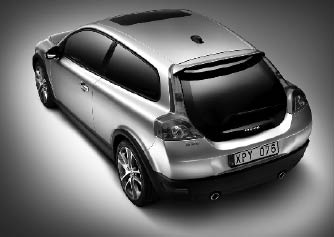Working the Gremlins out of Small-Car Styling
by Jim Corbran

Some of you probably remember the AMC Hornet of 1970—a rather dull, yet purposeful little sedan built by American Motors to do battle with Detroit’s Big Three automakers in the compact car segment. Then the Big Three moved on to fight the imports with smaller models, such as Ford’s Pinto and Chevy’s Vega, which both did nothing more than steal sales from larger Fords and Chevys. Poor little AMC didn’t have the cash to tool up another new car, so they simply took the Hornet, lopped off the back end and christened it the Gremlin. Ugly, but it served its purpose.
Fast-forward to 2007. Volvo takes its S40 sedan and similarly comes up with the C30 sport hatchback. Okay, maybe the guys manning Volvo’s cutting torches are a bit more artistic than those who took to the Hornet 38 years ago, but I imagine they also had a bit more time and money to come up with a pleasing design. The C30’s history actually can be traced back to the 1970s. At that time Volvo was selling a pretty little sport coupe called the P1800—Roger Moore drove a white one in the old British TV series The Saint. In 1971 they performed a similar design trick, adding on instead of lopping off, to come up the the 1800 ES sportwagon—a P1800 with an extended roof and an all-glass hatch which provided extra luggage capacity. The car otherwise was mechanically and visually the same as the sport coupe, and is a much sought-after collector car today. The C30’s roof and all-glass hatch pay tribute to the 1800ES.
That’s about where the similarities end. The C30 is much more than a shortened hatchback version of the S40. Besides the fact that Volvo tweaked the frontal styling, it also sits a bit lower and wider. It comes in two versions with very 21st-century names: 1.0 (starting at $22,700) and 2.0 (starting at $25,700). Both come with a five-cylinder turbocharged 2.4-liter engine which puts out 227 horsepower. It can be mated to a six-speed stick or a five-speed automatic transmission. Using the new EPA gas mileage estimates, you should get 19/28 city/highway miles per gallon with the stick shift, and 19/27 with the automatic. Interestingly, on Volvo’s own Web page gas mileage figures are 0/0 per gallon—which ain’t much! Usually automakers will put N/A if they’re not listing the actual figures; but a couple of goose-eggs? Where’s the Web page manager? Also to be noted here, premium fuel is recommended for the C30.

Some of the differences between the 1.0 and the 2.0: The 2.0 has Volvo’s lower and firmer dynamic suspension for better handling; it also comes with a high- performance audio system, consisting of Sirius satellite radio, an Alpine digital power amplifier, Dolby Pro Logic II Surround and 10 Dynaudio loudspeakers; body kit and roof spoiler; 18-inch wheels; and a few more exterior color choices.
The C30 is the smallest car in Volvo’s range, but it doesn’t skimp in the passenger safety department, long a Volvo mainstay. As Volvo puts it: “…the frontal structure is divided into zones which incorporate different deformation properties in a frontal collision.” In other words, the front should fold like an accordion before any of it intrudes on the passenger compartment in the event of a crash. To ensure this works the way it should, four different grades of steel are used to vary the “crumplishness” as it nears the passenger compartment. A similar system is in place in the rear of the car to protect occupants in the event of a rear collision. Sounds pretty complicated, but Volvo has been in the forefront of auto safety for decades, so it’s really no surprise.
You can see and read more at volvocars.us.
|
Issue Navigation> Issue Index > v6n36: Curtain Up! (9/6/07) > Working the Gremlins out of Small-Car Styling This Week's Issue • Artvoice Daily • Artvoice TV • Events Calendar • Classifieds |









 Current Issue
Current Issue